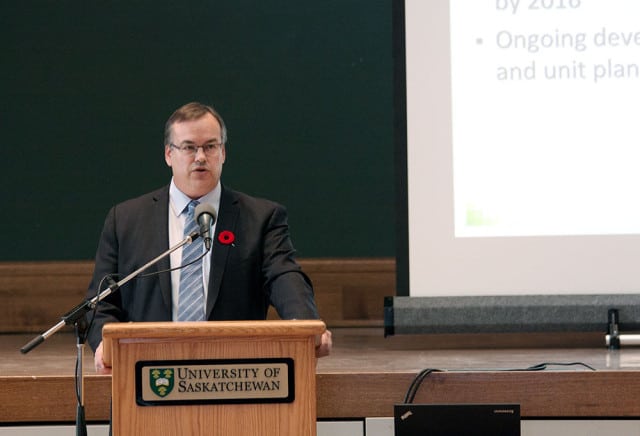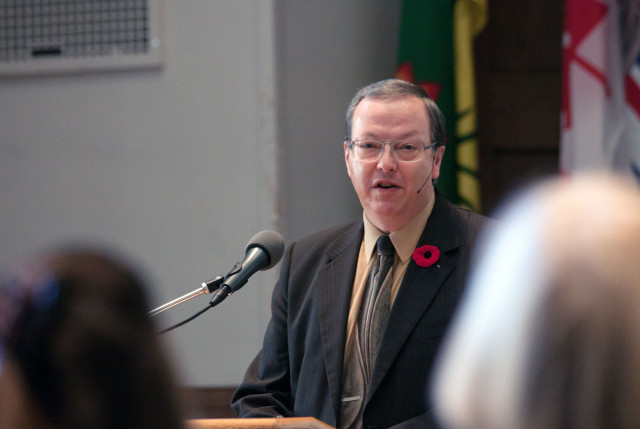
Vice-President Finance and Resources Greg Fowler outlined the timeframe for for various stages of the TransformUS process as the taskforce reports are due to the president on Nov. 30.
The Nov. 5 financial town hall began by outlining the University of Saskatchewan’s current financial state while combating the $44.5 million deficit projected for 2016. However, the focus quickly shifted to the crowd’s present priority: TransformUS.
University Provost and Vice-President Academic Brett Fairbairn and Vice-President Finance and Resources Greg Fowler were present to answer questions from the floor at the meeting.
TransformUS is the university’s largest initiative to reduce expenses, with a target of between $20 million and $25 million expected to be saved each year and $5 million of which will be reinvested into the university. The program prioritization plan evaluates the university’s academic programs and support services to determine which should be cut or receive more or less funding.
Zane Arnott, a fourth-year music education student, asked for a more detailed definition of the time frame students will have to complete their program if it is discontinued.
Fairbairn said the university will continue using the current method it has for phasing out programs. Programs that are usually completed in four years are phased out in a six to seven year time span while looking for opportunities where students can transfer into other areas.
“It’s about helping students meet their goals and fulfill the commitments the university and the students have made with each other,” Fairbairn said.
Fairbairn was also asked to clarify who the main decision makers will be when the recommendations from the taskforces are submitted.
Deans and unit leaders will develop plans for their programs based on the information gathered by the taskforces. The Provost’s Committee on Integrated Planning will develop and coordinate an implementation plan for the recommendations and oversee it across campus.
Once an operating budget has been developed and revised according to the PCIP’s plan, the Board of Governors will be responsible for approving it. University Council will participate in campus wide discussions of the reports and recommendations, coordinate decisions and actions.
Finally, the Senate will approve council’s actions based on the University of Saskatchewan Act — the provincial legislation that governs the U of S.

A concerned student asked university Provost and Vice-President Academic Brett Fairbairn what amount of time students will have to complete their program if it is slotted for deletion.
Another issue that was discussed was the reasoning for the long, drawn-out process of consultation that TransformUS has turned out to be.
Fairbairn said university administration could have made quick decisions behind closed doors but that those decisions would not have been effective nor would they have been accepted.
The TransformUS taskforces are ranking programs and services based on many criteria including quality, demand from undergraduate and graduate students, strategic priority and cost effectiveness.
“I have a suspicion that almost every program or service in the [U of S] will rank highly in at least one of those dimensions,” Fairbairn said. “If we have programs or services that are low in every criteria, I’m thinking we [will] probably have already addressed that in the past.
“The prioritization issue is not a simple question of calculating costs and revenues, even a less simple question of knowing quality. It’s a balancing of different factors that have to do with what’s important to us at the” U of S.
The taskforces will be expected to have their final recommendations submitted to the university president by Nov. 30 and will be released to the public on Dec. 9 “in their entirety and as provided by the two taskforces,” Fowler said.
Once the recommendations are released to the public, the university will begin a consultation process that ends on Jan. 31, 2014, where the president will meet personally with the deans to discuss their programs. There will be public town halls held on Jan. 8 and 9 in Convocation Hall from noon to 1 p.m. A special town hall will be held just for students on Jan. 15.
The public will be able to submit their feedback online throughout the entire consultation period.
“We strongly encourage you to actively participate in this vital stage of the process to ensure your voice is heard,” Fowler said.
Leadership meetings and research and financial models will be part of the analysis of the recommendations. If deletion of a program or service is suggested, the net savings will be calculated along with the effect it will have on other programs.
“Decisions will not be made lightly and will be made in consultation and coordination with all of our unit leaders,” Fowler said.
The implementation plan will be announced on April 30, 2014, and is slated to begin on May 1. Some decisions will be applied immediately while others may have to wait until the end of the planning cycle in April 2016.
—
Photo: Jordan Dumba/Photo Editor